![[Caradeu's flag, 1791]](../images/h/ht-cara.gif) image by Jaume Ollé, 11 January 1998
image by Jaume Ollé, 11 January 1998
Last modified: 2024-11-16 by rob raeside
Keywords: haiti |
Links: FOTW homepage |
search |
disclaimer and copyright |
write us |
mirrors
See also:
Other sites:
The first reported flag was the one used in the revolt of the
black people in 1790. This was white with a head of a black man.
Only reconstructed versions are known.
Jaume Ollé, 11 January 1998
![[Caradeu's flag, 1791]](../images/h/ht-cara.gif) image by Jaume Ollé, 11 January 1998
image by Jaume Ollé, 11 January 1998
One year later the Marquis de Caradeu, with supposed powers
from the French Assembly, established his power in the island.
His flag (shown above), "used for all the nation", was
reported by Ignacio Montenegro in Banderas.
Jaume Ollé, 11 January 1998
![[Flag of 1803]](../images/h/ht-1803.gif) image by Jaume Ollé, 11 January 1998
image by Jaume Ollé, 11 January 1998
The black leader Toussaint Louverture adopted in 1798 the
French tricolor. In January 1801 he was appointed governor and
occupied the Spanish part of the island. In the constitution of 8
July 1801 he was appointed governor for life. Between February
and June 1802 the island was occupied by French troops and
Toussaint was jailed. But in July 1802 the black people, led by
Dessalines, revolted. Other black leaders (Pétion, Christophe
...) helped the revolt and in February 1803 the independence of
Haiti was proclaimed. In the Petite Riviere d'Artibonite the
white band of the French flag was suppressed. The flag was
adopted as the military flag by the Congress of Arcahaie in May
1803 and was used generally with the Creole inscription
"liberté ou la mort" in white.
Jaume Ollé, 11 January 1998
The French troops were defeated during the battle of
Vertières (18 November 1803). Their capitulation allowed the
proclamation of Haitian independence on 1 January 1804 (and not
in February 1803 as erroneously reported above). Dessalines and
Pétion's were among the leaders of the anti-French insurrection
movement. The 18 May 1803 was the closing day of the Arcahaie
congress (15-18 May 1803), during which Dessalines had been
appointed general-in-chief of the insurrection army and had
adopted the motto "L'indépendance ou la mort"
(Independence or death) He also "diminished" the French
Tricolor of its white stripe to design the first blue-and-red
Haitian flag.
Ivan Sache, 2 December 2000
More on Dessalines "diminishing" the French Tricolor
flag: On 18 May 1803, last day of the congress of Arcahaie, all
of the local insurrection chiefs acknowledged the leadership of
Dessalines. He tore up a French flag and throw away the white
stripe. Catherine Flon, Mrs. Dessalines' goddaughter, sewed
together the two remaining stripes to make the first Haitian flag
Source: www.haitien.com.
5th stanza of the national anthem 'La Dessalinienne' (In
English, my own translation):
For the Flag, for the Nation,
It is good to die, it is good to die,
Our past shouts:
Thou shall have harden your soul.
It is good to die, it is good to die,
For the Flag, for the Nation,
It is good to die, die die,
For the Flag, for the Nation.
Source: www.haitionline.com.
Ivan Sache, 5 January 2001
Wasn't the French flag 2:3 at the time? That would make the
original Haitian flag square.
Peter Hans van den Muijzenberg, 7 January 2001
I can see only two explanations:
- the 'historical' square flag was later replaced with a
rectangular one.
- the story is another case of 'patriotic urban legend' invented
later than the event.
Ivan Sache, 9 January 2001
![[Flag of 1805]](../images/h/ht-1805.gif) image by Jaume Ollé 11 January 1998
image by Jaume Ollé 11 January 1998
On 8 October 1804 Dessalines was proclaimed emperor under the
name of Jacques I. He adopted a new flag on 20 May 1805: the blue
band was changed to black either to symbolise the people of the
island or to symbolise the words "freedom (red) or death
(black)". The order of the bands is doubtful.
Jaume Ollé 11 January 1998
According to
www.haiti-reference.com,
the black and red vertical flag was also used in 1805-1806 by the
empire of the west and between 1811-1820 by the kingdom of the
north.
Marc Pasquin, 8 August 2004
![[Flag of 1806]](../images/h/ht-1806.gif) image by Jaume Ollé 11 January 1998
image by Jaume Ollé 11 January 1998
After the events of Pont Rouge (17 October 1806) when
Dessalines was murdered, the empire was abolished and General
Pétion, ruler of the south and west, re-established the blue and
red flag.
Jaume Ollé 11 January 1998
![[Flag of 1811]](../images/h/ht-1811.gif) image by Jaume Ollé 11 January 1998
image by Jaume Ollé 11 January 1998
On 27 December 1806, General Henri Christophe, was named president and was recognised in the north, northwest and in Arbonite (1807). Christophe maintained the imperial flag of Dessalines. On 28 March 1811 he was proclaimed king under the name of Henri I, and the flag was changed slightly (according to professor Lux-Wurm): red in the hoist and black in the fly with, in the center, a shield with a phoenix under five five-pointed stars, all in gold on a blue background; the shield bore a crown and the Latin inscription 'ex cinerebus nascitur'.
In the rest of the country, General Pétion was proclaimed
president on 19 March 1807. Pétion changed his blue-red vertical
flag to horizontal, the same as the current
civil flag. The kingdom of Henri I was suppressed in 1818
after Pétion's conquest of the north. Boyer succeeded to Pétion
on 8 Octuber 1820 and maintained the horizontal flag. Rigaud
revolted in the south against Pétion and dominated the zone (3
November 1810 to June 1811) and after Rigaud was Borgella Gauman
(1811-12), but Pétion suppressed the revolt. The rebels under
Rigaud and Gauman used blue-red vertical or horizontal flags with
a red star in the blue stripe.
Jaume Ollé, 11 January 1998
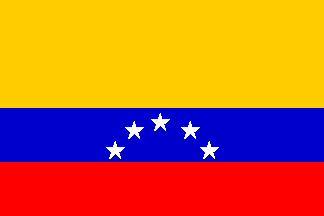 image by Ivan Sache, 29 June 2001
image by Ivan Sache, 29 June 2001
![[Spanish Haiti, 1821]](../images/d/do-1821.gif) image by Jaume Ollé, 18 January 1998
image by Jaume Ollé, 18 January 1998
reported WRONG flag
On 9 February 1822 Boyer annexed the Spanish part of the
island (now the Dominican Republic) which a
few months before had proclaimed its independence from Spain (30
November 1821) under the name Republica del Haiti espanol
(Republic of Spanish Haiti). Some days later General Caceres
proclaimed its union with Great Columbia,
but nine weeks later the Haitians occupied the country and the
republic ended. The flag of Spanish Haiti is shown above. In the
first weeks of 1822 the flag of Great Columbia was in use.
Jaume Ollé, 18 January 1998
The image of the Colombian flag of Haiti has wrong colours. It
really are the Colombian colours! This flag has been printed on a
Haitian postage stamp.
Ralf Stelter, 2 July 1999
In fact it is logical because this flag was used when Saint
Domingo was part of the Republic of Great Colombia.
Jaume Ollé, 2 July 1999
The last issue of Franciae Vexilla (#22/68, June 2001) is
totally dedicated to Haiti, with papers by Olivier Corre and
Herve Calvarin. Concerning the independent state of Spanish Haiti,
as reported by Ralf Stelter, Jaume's image is erroneous. It
should be the Colombian flag in its colors and stripe proportions
with an arc of five white stars.
Ivan Sache, 29 June 2001
This flag appeared in a stamp dated 1971, devoted to the
"first independence". I have a photocopy of a catalogue
where the flag is shown in w/b, but colors are quoted as
"outremer, jaune et rouge" (i.e. dark blue, yellow and
red). The upper stripe is darker that the central one.
Jaume Ollé, 29 June 2001
In the discussion about the correct version of the flag, the
possible support for the blue-yellow-red version lies in Jaume
Olle having seen a black-and-white copy of a 1971 stamp which
appears to show the flag like this. However, the stamp can now be
seen here to actually show
the flag as yellow-blue-red.
Source: www.flagsonstamps.info
Ole Martin Halck, 30 July 2007
![[Flag of Haiti, 1849-1859]](../images/h/ht-1849.gif) image by Jaume Ollé, 18 January 1998
image by Jaume Ollé, 18 January 1998
The Haitian Constitution of 1843 confirmed the horizontal blue
and red flag (article 192) and it was confirmed in subsequent
constitutions. An attempt to restore the black and red flag which
was made in 1844 failed. In 1847 Faustin Soulouque was elected
president and in 1849 he proclaimed himself emperor under the
name of Faustin I (1849-59). The blue-red flag was confirmed in
the 1849 constitution but the shield was modified. Faustin's
Empire ended on 15 January 1859. No change was made in the flag
but the previous arms were restored.
Jaume Ollé, 18 January 1998
At J.W Norie - J.S. Hobbs: Flaggen aller seefahrenden
Nationen, 1971 [nor71] (original
print 1848):
292 Hayti - horizontal blue and red flag.
Peter Hans van den Muijzenberg, 12 November 2001
Accordibg to
www.haiti-reference.com,
the horizontal blue-red said to have been first adopted by
General Pétion for the republic of the west and to have become
the national flag after 1820 .
Marc Pasquin, 8 August 2004
Flag According to Steenbergen Book (1862)
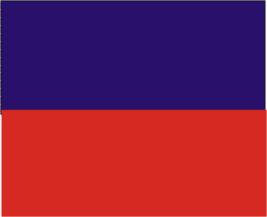 image by Jaume Ollé, 26 July 2003
image by Jaume Ollé, 26 July 2003
No. 832 - Haiti.
Source: [stb62]
Jaume Ollé, 26 July 2003
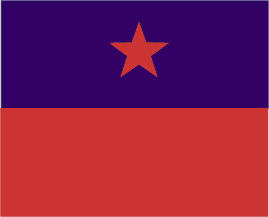 image by Jaume Ollé, 19 August 2003
image by Jaume Ollé, 19 August 2003
No. 860 - Hayti [Note that was a rival government as was
reported in Francia Vexilla].
Source: [stb62]
Jaume Ollé, 19 August 2003
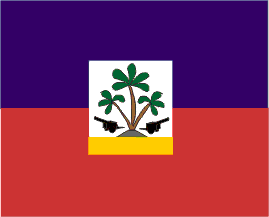 image by Jaume Ollé, 19 August 2003
image by Jaume Ollé, 19 August 2003
No. 861 - Hayti [Note that Steenbergen didn't knew the arms
well, but he tried to draw an image that has a similarity with
the arms].
Source: [stb62]
Jaume Ollé, 19 August 2003
![[Reported imperial flag, 1862]](../images/h/ht-imp.gif) image by Jaume Ollé, 10 September 1996
image by Jaume Ollé, 10 September 1996
In an old atlas (Frangott Bromme, Multrirter Hand-Atlas der
Geographie und Statistik, Stuttgart 1862) there is a blue and
white horizontal flag with a central square containing a red and
green flower. W. Smith identifies this flag as that of the Haiti
Empire.
Jaume Ollé, 7 September 1996
Blue and white on a Haitian flag is certainly a new one
on me - I thought that the horizontal blue-red flag was in use
from 1822-1964. It's possible, of course, that the flag you
describe isn't the national flag but the flag of a would-be
dynasty or faction.
Stuart A. Notholt, 6 September 1996
This flag is shown in the Brommer Atlas (1864) and is labeled
'Empire of Haiti' but I think that it may be a mistake (white
instead red).
Jaume Ollé, 23 January 1996
The reported flag of blue over white is a printing error. Both
sources we have showing that flag also show a yellow-white-red
flag for Ecuador!
But the emblem in the center is interesting! Colour the leaves in
blue and red and the flower on top with heavy green leaves, the
base green etc. and it becomes the palmetto-emblem. We have
several illustrations of this "coat of arms" but all are in
outlines only and without colours! So probably it was only a
sketch .I believe it is a mistaken coat of arms.
Ralf Stelter, 2 July 1999
If I remember right when I posted the flag, there was discussion about it. It is shown in Brommer's Atlas with
a presentation by W. Smith. It seems as a mistake but it is
labeled "Haiti empire" and the arms are unknown and
therefore must be considered as possible or if it is not, then not
only the white color is wrong, but also the arms (as Stelter
said) and I considered that it might be a real flag. This
Atlas shows also another interesting flag: the one of Los Altos
in vertical bands with a bird in center that is similar to an
eagle instead to a "Quetzal". Somer sources give for
Los Altos the flag in vertical arrangement and another in
horizontal arrangement.
I believe that it can be labeled "Haiti empire according
to Brommer Atlas"
I don't remember that in Brommer Atlas the flag of Ecuador is
shown in wrong colors,
and unfortunately I can't check it. Certainly the arms are shown in
full color and I believe that I reproduced that as accurately as
posible.
Jaume Ollé, 2 July 1999
In the flagbook of Mr. W. Wezepoel, from 1862, which is stored
in the Zeeuws Archief in Middelburg.(NL): Haiti - blue over white
bicolour. My own suspicion about this flag is that it was based on a
printing error whereby the red was left out in some illustration
of the Haitian flag, and was then uncritically repeated by
others.
Jarig Bakker and Ned Smith, 30 November 2004
Flag According to Steenbergen Book (1862)
 image by Jaume Ollé, 26 July 2003
image by Jaume Ollé, 26 July 2003
No. 830 - Haiti.
Source: [stb62]
Jaume Ollé, 26 July 2003
 image by Antonio Martins-Tuvalkin, 3 September 2008
image by Antonio Martins-Tuvalkin, 3 September 2008
There is only one of these in 1858 US flag chart [hbl58]: "Hayti" at
position (1:9): Rectangular ~2:3 horizontal blue over white
biband, matching the report from Steenbergen.
António Martins-Tuválkin, 3 September
2008
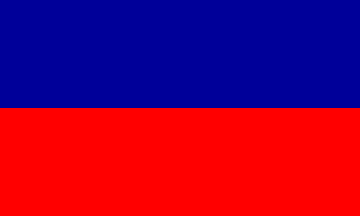 image by António Martins, 27 November 2001
image by António Martins, 27 November 2001
In the second half of the 19th century and in the 20th century
the current flag was in use: the national flag and ensign is a plain
bicolor; the state flag and naval ensign with the addition of the
arms on a central square. The civil flag is the origin of the
incident in the Olympics Games of 1936 when Liechtenstein had to
change its flag to distinguish it from the Haitian one.
Jaume Ollé, 18 January 1998
The Haitian national flag 1936 was the motive for a change in the Liechtenstein national flag , as
both were simple blue over red bicolors (nothing is said about
ratio and specific shades). This flag must have been in use from
c. 1860 to 1957.
António Martins, 27 November 2001
Reported flags of a reported king in La Gonave, Haiti from Bruno Fuligni's "L'Etat c'est moi", 1997 [fuL97]
"Faustin II of La Gonave.
Historical context :
There was a treaty of protectorate between USA and Haiti signed
in 1915. That's the reason why the United States established a
police station in Anse-à-Galets, island of La Gonave, 40 miles
West of Port-au-Prince.
Faustin Wirkus was born 1897 in Pennsylvania from Polish parents.
He engaged himself at 17 in the Marine Corps (French text says :
"fusiliers marins"), discovered therefore Haiti in
1915, became later sergeant in Cuba, came back to the USA, and
served at Haiti from 1919. In 1925, he asked to get the
commandment of the station of La Gonave (12.000 inhabitants,
organized in ten "Congo societies" Each society has its
own banner and queen, and there is a supreme queen, Ti Memenne).
When the queen learned that Wirkus' first name was Faustin, she
was impressed, and her "hougan" (witch) declared that
Wirkus was the reincarnation of Faustin I, the
emperor of Haiti. So, the American sergeant became king of La
Gonave. It is reported that two young women came and raised two
flags in front of the door : one was plain yellow and the other
one star-spangled blue - each star stood for a Congo society.
(well, that makes 10 stars...).
Queen Ti Memenne said : "Here are your flags, King! They are
symbols of your authority : these women are the keepers of the
flags, and they will stand behind you bearing your flags, they
will walk with you during processions". (the whole ceremony
is then described in the book).
The writer William Seabrook, who visited Haiti at that time,
told that story in a book. Later, the president of Haiti heard of
it, and decided it was not possible to accept that there is a
king in the Republic of Haiti. "Faustin II" was
therefore forced to leave in 1929, in order to remedy to the
"bad consequences of staying too long in far away military
stations".
I don't know what the stars of the blue flag looked like, and how
they were arranged.
Olivier Touzeau, 23 December 2000
![[State flag, 1964-86]](../images/h/ht-gv64.gif) image by
Clay Moss, 26 May 2014
image by
Clay Moss, 26 May 2014
Duvaliar was elected president in 1957 and took all power in
1960. In 1963 the single party system was established. A new
constitution was adopted on 25 May 1964 which restored the black
and red flag. This design was oficially readopted on 21 June
1964. The state flag and naval ensign included a white square
with the full arms. Duvalier died on 21 April 1971. His son, Jean
Claude was proclaimed president. After a popular revolt, Jean
Claude fled to France in February 1986. In the revolt the old
blue and red flag (without the arms) was used. It was later
readopted "de facto" as national flag and ensign and
was officially readopted by a decree of 25 February 1986 and
confirmed by the constitution of 1987. The state flag and naval
ensign included the white square with arms, but the flags in the
arms continued to be vertically divided. Later a modification of
the decree removed this discrepancy and the shield now has the
flags horizontally divided.
Jaume Ollé, 18 January 1998
A black-red vertical bicolour was used from 1964 to 1986
during the dictatorship of the Duvaliers: the state flag was
charged with the arms but the civil flag was plain. Note that the
cap of liberty was omitted from the arms during this period.
Vincent Morley, 10 January 1998
Smith [smi75c] and [smi82] show the 1964 version of the
flags, vertically divided black and red. For the state flag Smith
gives symbol meaning "variation", I guess, just to
indicate that the size and artistic rendition of the coat of arms is not
consistently used and may vary (significantly).
Željko Heimer, 31 October 2001
I read that in 1964 the Haitian Coat of Arms had no red cap at
the top.
Victor Lomantsov, 4 November 2001
I believe the coat-of-arms would also show
"vertically" divided black and red flags.
Santiago Dotor, 5 November 2001
Our illustration of the 1964 flag shows a Cap of Liberty above
the palm, but the notes below suggest that it was deleted on this
version. I can confirm that Article 191 of the Constitution
dated 21 June 1964, omits reference to the Phrygian Cap (which
occurs in all other official descriptions of the arms), and can
suggest therefore, that the illustration requires amendment?
Christopher Southworth, 10 November 2003
This prompted me to get my copy of a Haitian flag out and look
at it as it was made in the last 3-4 years. It still
includes the Phrygian Cap. I'm not sure if we have it is de
facto versus de jure flag situation; an omission from the
Constitution or what. I called the US company that
manufactures flags for the UN (Annin & Co.) and they said
that they knew of no such amendment. Maybe a call to the
local embassy would clarify any questions.
Paige Herring, 10 November 2003
I don't believe there is any doubt that the current arms
include the Cap of Liberty, however, if the written evidence is
anything to go by it was removed when the arms and flag were
amended in 1964, and whilst the blue-red was restored by a Decree
of 11 February 1986, restoration of the Cap (probably through an
oversight) had to wait until Article 3 of the Constitution dated
10 March 1987.
Christopher Southworth, 11 November 2003
The change to black was on the order of "Papa Doc"
Duvalier. Black was first used in 1805 probably to represent the
people of the island. They went back to blue (with minor
exceptions) until Duvalier. It was for the black African heritage
of the people. Certainly not socialist or anarchist.
Albert S. Kirsch, 21 October 2004
I noticed that he had imposed the current coat of arms onto his flag and
changed the blue colors in the flags to black. This is a common mistake that
people occasionally make. In fact, I did the same thing when I first drew this
flag.
That said, the flags in Haiti's coat of arms from 1964 to 1986 were vertical
bicolors, representing both Haiti's government and civil flag/ensign of the
time. Additionally, the liberty cap was removed from the coat of arms. So, I
have submitted a more accurate rendition of the 1964-86 government flag.
I frequented Haiti quite a bit in those days, and purchased several flags during
my travels. There used to be a fairly nice flag manufacturing outfit in Port Au
Prince, and I bought my flags there. I think that it may have been leveled
during the earthquake.
It should be noted that whatever the official proportions were supposed to be
for Haiti's Duvalier period flags, they were all locally made in 1:2
proportions. Where government flags were concerned, the rectangle containing the
badge was always half in width the width of the hoist. As far as length of the
rectangle was concerned, it could vary a bit, but not too much. The badge I have
submitted is a faithful rendition of one of the Haitian made samples in my
collection.
The reason I believe that the old flag maker's place may be gone is because
during my visit to Haiti last summer, I saw nothing but Chinese made polyester
flags flying in Port Au Prince and out in the countryside. And, I didn't see too
many of those.
Clay Moss, 26 May 2014
We've
finally got the right coat of arms for the Duvalier flag.
Christopher Southworth, 26 May 2014
![[State flag, 1964-86]](../images/h/ht_1.gif) image by BlinxCat, 1
June 2022
image by BlinxCat, 1
June 2022
based on photo
This Duvalier-era Haitian Flag is a variant I spotted in a set of South
American flags along with Caribbean flags too, what makes this variant
interesting is how the emblem is detailed, going as far as even adding clouds in
the sky of the badge and making it a unique art style.
BlinxCat, 1
June 2022
 image by Željko Heimer, 31 October 2001
image by Željko Heimer, 31 October 2001
The civil flag and ensign of the Duvalier era, a simple
vertical black and red bicolor.
Ivan Sache, 30 June 2001

image by Željko Heimer, 31 October 2001
No war pennant is shown, but I think we could safely assume
that black over red pennant was used.
Željko Heimer, 31 October 2001